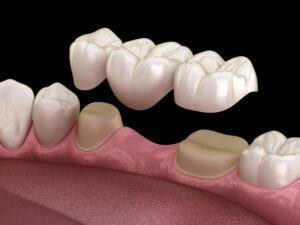
A dental bridge is a trusted solution for replacing one or more missing teeth, designed to be a durable and long-lasting part of your smile. However, accidents or wear and tear can sometimes cause a dental bridge to come loose or fall out. If that happens, it can be alarming, but the most important thing is not to panic. Taking the right steps quickly can protect your teeth and gums and improve your chances of having the bridge successfully re-cemented or replaced.
Here’s what to do if your dental bridge falls out.
Stay Calm and Save the Bridge
The first step is to retrieve the bridge and keep it in a safe place. Handle it gently to avoid damaging it. If possible, rinse it off with water to remove debris, but do not attempt to clean it aggressively or try to glue it back in yourself. Household adhesives are not safe for use in your mouth and can cause irritation or infection.
Keep the bridge in a clean container or a plastic bag and bring it to your dental appointment.
Examine Your Mouth
Next, take a look at the area where the bridge was. Check for any signs of damage such as bleeding, pain, swelling, or sharp edges on the abutment teeth (the teeth that supported the bridge). You may also notice increased sensitivity or discomfort when exposed to air, hot or cold drinks, or chewing.
If you’re experiencing significant pain or swelling, contact your dentist right away, as these could be signs of an underlying issue that needs prompt attention.
Avoid Certain Foods and Habits
Until you can see your dentist, try to avoid chewing on the side of your mouth where the bridge was. Stick to soft foods and avoid anything sticky, crunchy, or hard that could irritate the exposed area or damage neighboring teeth. Avoid touching or prodding the area with your tongue or fingers, as this can worsen sensitivity or introduce bacteria.
Call Your Dentist Immediately
As soon as your bridge falls out, contact your dental office. Even if you’re not in pain, a missing bridge exposes your teeth and gums to potential harm. The longer you wait, the more likely you’ll develop problems such as shifting teeth or gum irritation.
Your dentist will examine your mouth, evaluate why the bridge came out, and determine whether it can be re-cemented or if a replacement is necessary. Sometimes, the underlying teeth may have decayed or changed shape, requiring adjustments or further treatment before a new bridge is placed.
Prevent Future Issues
Once the bridge is reattached or replaced, follow your dentist’s care instructions closely. Good oral hygiene, regular dental checkups, and avoiding habits like chewing on hard objects can help prolong the life of your bridge and reduce the risk of future problems.
If your dental bridge falls out, acting quickly and responsibly makes all the difference. Save the bridge, protect your mouth, avoid self-repair attempts, and get in touch with your dentist as soon as possible. With the right care, your smile can be restored quickly and effectively.
About the Practice
Here at Windermere Dentistry, we’re prepared to help you if your restoration falls out. We take a state-of-the-art approach with high quality dentistry in a no-pressure environment where we’ll never push unnecessary treatments on you. With our flexible payment options, we’re also committed to helping ease the financial burden of dental work. Schedule your appointment today online or call us at (407) 258-1330.
